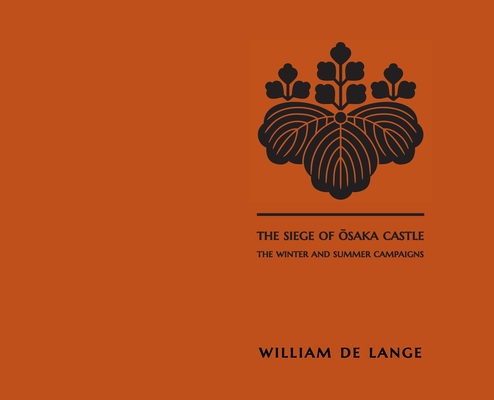The Siege of Osaka Castle: The Winter and Summer Campaigns

The Siege of Osaka Castle: The Winter and Summer Campaigns
The siege of Ōsaka Castle is the stuff of legends. In the winter of 1614 two hundred thousand warriors loyal to the House of Tokugawa gathered south of Ōsaka to lay siege to its imposing castle. Inside the castle, seventy thousand warriors loyal to the House of Toyotomi braced themselves for a siege that would evolve into two hard-fought conflicts: the Winter and Summer campaigns.Known in Japan as the Ōsaka no Jin or the Ōsaka Battle Array, it was more than just the largest battle for Japan's biggest stronghold; it was the culmination of a nationwide movement toward the country's unification. That movement had been set in motion by Oda Nobunaga. It was continued by his general Toyotomi Hideyoshi. And it was almost completed by his ally Tokugawa Ieyasu when, in 1600, he emerged victorious from the Battle of Sekigahara.Ieyasu's victory was not complete. Large and powerful forces still opposed the Tokugawa ascendancy. It was Toyotomi Hideyori-the young and only son of the man who had campaigned hardest to unite the realm-who threatened to undo all that hard work when, in the summer of 1614, he mobilized those forces at Ōsaka Castle. Victory in the subsequent siege not only decided which House was to rule Japan; it also meant an end to the most destructive one-and-a-half century in Japanese history, a period now known as the Warring States period.This work explores the events that led up to the eventual standoff between the two Houses: the lingering resent-ments, the attempts at emasculation, the last-ditch efforts at reconciliation, and the inexorable- move toward confrontation. It goes on to describe in meticulous detail the many battles of the Winter and Summer campaigns, the strategies of the commanders, their troop strengths, and it identifies most of them by name and rank.Richly illustrated and presented in a wide, 11-by-8.5-inch landscape format, this work presents modern recon-structions as well as contemporary maps of early 17th century Ōsaka and its environs. Further detailed maps reveal the troop positions and movements during the Tokugawa raids against the Toyotomi forts during the Winter Campaign and the battles during the Summer Campaign: at Kashii, at Dōmyōji, at Wakae, at Yao, at Tennōji, and finally during the storming of the castle.Explanatory sections provide extensive information on a variety of topics: bullion, battle-ships, historic sites and buildings, interesting details in old maps, as w
PRP: 413.25 Lei
Acesta este Prețul Recomandat de Producător. Prețul de vânzare al produsului este afișat mai jos.
371.93Lei
371.93Lei
413.25 LeiLivrare in 2-4 saptamani
Descrierea produsului
The siege of Ōsaka Castle is the stuff of legends. In the winter of 1614 two hundred thousand warriors loyal to the House of Tokugawa gathered south of Ōsaka to lay siege to its imposing castle. Inside the castle, seventy thousand warriors loyal to the House of Toyotomi braced themselves for a siege that would evolve into two hard-fought conflicts: the Winter and Summer campaigns.Known in Japan as the Ōsaka no Jin or the Ōsaka Battle Array, it was more than just the largest battle for Japan's biggest stronghold; it was the culmination of a nationwide movement toward the country's unification. That movement had been set in motion by Oda Nobunaga. It was continued by his general Toyotomi Hideyoshi. And it was almost completed by his ally Tokugawa Ieyasu when, in 1600, he emerged victorious from the Battle of Sekigahara.Ieyasu's victory was not complete. Large and powerful forces still opposed the Tokugawa ascendancy. It was Toyotomi Hideyori-the young and only son of the man who had campaigned hardest to unite the realm-who threatened to undo all that hard work when, in the summer of 1614, he mobilized those forces at Ōsaka Castle. Victory in the subsequent siege not only decided which House was to rule Japan; it also meant an end to the most destructive one-and-a-half century in Japanese history, a period now known as the Warring States period.This work explores the events that led up to the eventual standoff between the two Houses: the lingering resent-ments, the attempts at emasculation, the last-ditch efforts at reconciliation, and the inexorable- move toward confrontation. It goes on to describe in meticulous detail the many battles of the Winter and Summer campaigns, the strategies of the commanders, their troop strengths, and it identifies most of them by name and rank.Richly illustrated and presented in a wide, 11-by-8.5-inch landscape format, this work presents modern recon-structions as well as contemporary maps of early 17th century Ōsaka and its environs. Further detailed maps reveal the troop positions and movements during the Tokugawa raids against the Toyotomi forts during the Winter Campaign and the battles during the Summer Campaign: at Kashii, at Dōmyōji, at Wakae, at Yao, at Tennōji, and finally during the storming of the castle.Explanatory sections provide extensive information on a variety of topics: bullion, battle-ships, historic sites and buildings, interesting details in old maps, as w
Detaliile produsului










